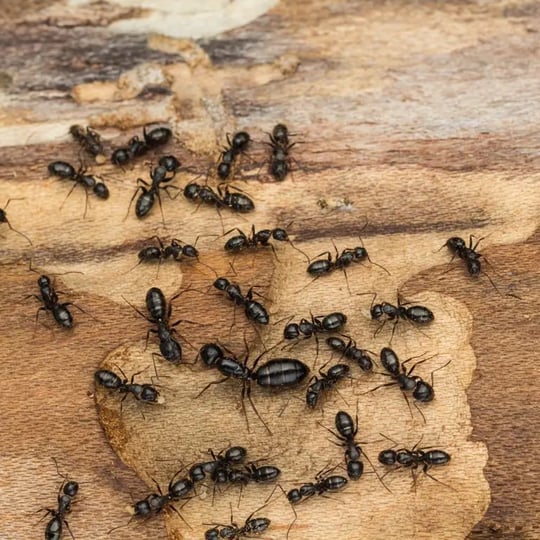Pest Identification Information | Green Pest Solutions
Carpenter Ants

Scientific Name: Camponotus pennsylvanicus
Lifespan: 25+ years for queens, 1 year for workers.
Problem: Property damage, food theft
Carpenter ants are large, property-damaging ants that are found throughout the world. Unlike the similarly problematic termite, the carpenter ant nests, rather than feeds, on the wood it infests. Black carpenter ants (Camponotus pennsylvanicus) are the type that most commonly infest houses in the U.S.
The Carpenter Ant Life Cycle
- Eggs – Carpenter ant queens lay thousands of eggs throughout their lives, which are small, white and contained within the nest. The nests are created in moist locations (primarily outdoors) that favor the development of the eggs into larvae.
- Juveniles – Ant larvae are legless and soon pupate, forming cream-colored cocoons and slowly developing into their adult forms. A carpenter and develops into a mature ant over the course of about 2 months.
- Mature Bugs – Mature carpenter ants vary in size but generally range from 1-2 cm in length. They have shiny, black bodies with small whitish-yellow hairs on their abdomens.
Carpenter Ant Habitats and Habits
Carpenter ants tend to nest outdoors, and prefer damp, rotting wood that provides the moisture they require for their young to develop properly. In creating their colonies, carpenter ants will often tunnel through the wood that human houses are primarily composed of, hollowing it out along the grain and making homes structurally unsound. They may also target fences and stacks of firewood near the home.
In terms of eating habits, carpenter ants are attracted to anything sweet, including berries, rotten fruits, dead bugs and the juices of other bugs, like aphids, harvest from the plants they suck on.
How to Recognize and Get Rid of a Carpenter Ant Infestation
The following signs indicate a possible carpenter ant infestation in your home:
- Wood that makes a hollow sound when knocked or breaks easily
- Wood hollowed out along the grain, or trees that have been hollowed along their internal rings
- Piles of wood shavings
- Small holes in hollowed wood
- Sighting of carpenter ants near food sources such as sugar and fruit
Once you have determined that you have carpenter ants rather than termites (look for the holes in the hollowed wood and piles of wood shavings), you can begin to get rid of them by creating toxic bait out of sugary substances mixed with ant poison. However, due to the potential for property damage, a more immediate treatment is often required.
Need Help with Carpenter Ant Information | Ant Removal & Treatment PA, NJ & DE?
Call today at and let's talk about how we can help you with Carpenter Ant Information | Ant Removal & Treatment PA, NJ & DE and other Pest Library.